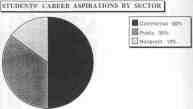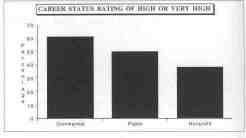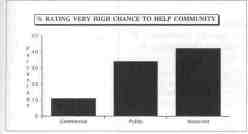Student Perceptions of
Leisure Service Careers
Research reveals that most students today chose careers in commercial
recreation, and a job in the public sector may be a "default" option
BY DANIEL G. VODER, JOHN WEBER AND
CYNTHIA J. WACHTER
|
(This research)
suggests a
growing disparity
between the
demand for and
supply of
competent and
enthusiastic public
leisure service
personnel in the
state of Illinois.
|
For many of us who prepared for careers in recreation
and parks by attending colleges and universities in the
1960s, 1970s and 1980s, the only "real" option was
working in the public sector at either the local, state or
federal level. Our professors and mentors did recognize
the "other" areas, but usually only in passing. Some students eventually found careers in the nonprofit and commercial venues, but in many cases it was by default. They
were unsuccessful in finding positions in park districts
or municipal settings or the state or federal government
and they settled for something else.
Today that is no longer the case. Careers in leisure
services in the public sector are no longer "the only game
in town." Students can now opt for careers in the commercial and nonprofit arenas as well as in the burgeoning corrections industry, military recreation and the corporate realm.
Instead of 80 percent of park and recreation students
entering the public sector and the other 20 percent
spreading themselves across the various other fields, the
opposite appears to be true in the '90s. This trend could
result in serious consequences for the future provision
of public leisure services at the local level in the state of
Illinois.
Research Goals and Method
This exploratory research project examined the attitudes of leisure service majors in Illinois universities toward careers in recreation and parks in the public, commercial and nonprofit sectors. Specifically, the objectives
of the study were to determine the percentage of students who aspire to careers in each of the sectors and
what perceptions they hold of careers in the various sectors.
Self-administered questionnaires gathered demographic and attitudinal information from recreation and
park majors at Western Illinois University, Illinois State
University and Eastern Illinois University in the fall of
1997. The majority of the questions on the survey were
closed-ended. For example, the survey included the question, What is your opinion of entry level wages in the
public leisure service sector? Response options included
very high, high, average, low or very low. In addition,
the researchers sought more detailed information by including an open-ended question to determine students'
primary reasons for aspiring to careers in a particular
area.
Following brief instructions, including a statement that
completion of the questionnaire was voluntary and responses were anonymous, professors handed out a total
of 404 survey instruments during class. Although a few
of me questionnaires were only partially completed, all
were returned promptly. The high response rate (which
approached 100 percent) and the researchers' belief that
the students from the three aforementioned institutions
were representative of students in leisure service programs in other Illinois universities and colleges, allowed
the researchers to make inferences and conclusions with
some degree of confidence. Moreover, the responses by
students did not differ significantly between institutions.
This does not mean that other institutes of higher education in Illinois might not produce different results with
the same survey.
The problems of dividing the leisure services field into
three separate sectors are fully appreciated. The growth
of shared revenue sources, the adoption of business principles and marketing strategies and cooperative endeavors has contributed to a blurring and subsequent confu-
January/February 1999 /17
sion of the private, public and nonprofit
worlds. Moreover, some students aspire for
careers in areas in which opportunities exist
in multiple sectors. For example, outdoor recreation positions can be found in private,
nonprofit and public agencies. To address the
issue, the survey included a short explanation and diagram to explain this common
classification system and its use in the questionnaire.
Findings
Valuable insight can be gained by considering the overall profile of the students involved in the study. Respondents were evenly
split between males (49%) and females
(51%). Ninety-four percent (94%) were undergraduate students and 80% of all respondents were recreation or leisure service majors. The majority (75%) had taken their first
recreation class since 1996 with 48% having taken their first class in 1997. Many students indicated they had previously worked
in the leisure service field: 41% in the public sector, 37% in the commercial sector and
34% in the nonprofit sector.
|
Chart A

STUDENTS'CAREER ASPIRATIONS BY SECTOR
|
Career Aspirations
One of the most informative questions
posed to students focused on their career
aspirations. In response to the statement,
"Indicate the sector in which you would most
like to work," 50% percent indicated they
would most like to work in the commercial
sector, 35% preferred to work in the public
sector and 15% hoped to work in the nonprofit sector (see chart A).
|
|
Chart B

CAREER STATUS RATING OF HIGH OR VERY HIGH
|
Career Status
Respondents held different perceptions of
the status of careers in the different areas.
Employment in the commercial sector held
the highest perceived status with 61% of the
respondents indicating either very high or
high status. Fifty percent (50%) of the students perceived that a public sector career
rated either very high or high status. Only
38% indicated that a career in the nonprofit
sector warranted very high or high status (see
chart B).
|
Use of Technology
Students believe that technology is used
much more in the commercial sector, less in
the public sector and the least in the nonprofit sector. Eighty percent (80%) of the
students rated the use of
technology in the commercial sector as being "very
much" or "much" in comparison to 56% of similar responses in the public realm
and only 30% in the nonprofits.
Wage and Compensation
|

|
Because wages and other
compensation are of particular importance to those contemplating a particular career
field, the survey posed several related questions in this
area. Students' perceptions of
entry-level wages were realistic. Nineteen percent
(19%) thought that entrylevel wages in the commercial sector were either high
or very high, 10% thought
that entry-level wages were
high or very high in the public sector and 4% of the respondents perceived entry-level wages to be
high or very high in the nonprofit realm.
Only nonprofit agencies' entry level wages
were rated low by more than half of the students.
|
When this information is combined with
data regarding perceptions of top management salaries, significantly different perceptions of the three sectors become evident.
Seventy-six percent (76%) of the respondents
thought that top management salaries in the
commercial arena were either high or very
high; 56% thought that the salaries paid to
top management in the public sector were
high or very high and only 36% believed
that top managers in the nonprofit sector
made high or very high salaries.
Not surprisingly, students' perceptions of
the benefit plans for each sector are consistent with their perceptions of salaries. Commercial sector benefits plans are rated highest, the benefit plans of the public sector are
in the middle and the benefit plans in the
nonprofit sector are perceived to be the lowest (see chart C).
Getting a Good Job
Interestingly, students are equally optimistic about "getting a good job" in each area.
The chances of getting a good job in the
commercial sector are rated very good or good
according to 68% of the students, 67% believe that to be the case in the public sector
and 65% in the nonprofit sector.
The optimism shown by students in regard to getting a good job appears to carry
over into the perception of their chances of
advancement in each sector. The commercial sector once again leads the way with 75%
of the students rating the chances of advancement as very good or good followed by 66%
in the public sector and 60% in the nonprofit sector.
Helping the Community
|

|
The question regarding the students' perception of the "chances of helping your community" shows the greatest difference with
the nonprofit sector rated highest (42% believe they have a very good chance of doing
so), the public sector rated in the middle with
33% perceiving a very good opportunity and
the commercial sector last with only 11%
indicating a very good chance of helping their
community (see chart D).
|
Conclusions and Discussion
What do college students think of careers
in leisure service in the public, commercial
and nonprofit sectors?
18/ Illinois Parks and Recreation
The commercial sector appears to be a very
attractive career choice for students. Of the
three areas, it is rated number one in terms
of status, the amount of technology employed, entry level salaries, top management
salaries, benefits packages, opportunities for
advancement and the chances of getting a
good job out of college.
At the other end of the spectrum, the nonprofit sector has the lowest career status, uses
little technology, and has the lowest compensation plans including entry level wages,
top management level salaries and employee
benefits. On only one quality did nonprofits
rate the highest: that of the possibility of
helping the community.
In every case, careers in the public sector
fell between the extremes. It was lower in
status than working in the commercial sector but above the status of working in the
nonprofit sector. The amount of technology
used to accomplish the job in the public
realm was in the middle. Students indicated
that they thought the wages, salaries, benefits and chances of advancement were better than those in nonprofit agencies but not
as good as those found in the commercial
sector. The chance of doing good for the
community was not as good as that in the
nonprofit area but much better that the opportunity of doing good
things for the community in
the commercial sector.
Given these perceptions
(and it is important to remember that these are perceptions only and may or may
not reflect reality) it should
be no surprise that 50% of
the students aspire to leisure
careers in the commercial
field. The narrative answers
to the open-ended questions
regarding this interest supports the quantitative data.
The following candid
narrative response captures
the sentiment of many students: "It (the commercial sector) is the best opportunity to
make the most money."
Others mentioned that
they liked the idea of "being
entrepreneurial and someday
owning my own company. "
The narrative responses
for having an interest in a career in the nonprofit sector were also consistent with the
short answers. An altruistic theme was clearly
evident. Several made note that they expected
to earn considerably less money in this area;
however, they were willing to make the sacrifice. According to one: "I have volunteered
in the nonprofit field and now it is my major
Interest. I feel it is a way to make a difference."
The reasons expressed for going into the
public sector were much more varied. Some
students commented on their perception that
the pubic sector offered the best opportunities for "making quality programs that can be
offered to almost anyone." Others noted that
careers in outdoor recreation or therapeutic
recreation would most likely occur in the
public sector. The chance to interact with a
diverse collection of professionals and clients
was attractive to some students.
For the most part, previous work experiences in the public sector (usually in the summer months) seemed to have been positive
and created an interest in the field. After indicating a strong aspiration for a leisure service career in the public sector one student
wrote: "I have worked there for three years, I
know how things are run. I like the public sector. "
One narrative response provides an interesting insight not only because of what was
written but because of what was not written. An undergraduate student noted: "I am
split between the nonprofit and the commercial sector. I would like to benefit my community but making a living and good money is
why I'm going to college. "
In recognizing the salient qualities of the
commercial and nonprofit areas, the student
seems to have overlooked the public sector.
The data, when considered as a whole, suggests that some of the erosion of interest in
public sector leisure service careers might be
related to this phenomenon of gravitation
to the extremes. If students desire to make a
lot of money and live very comfortable lives
they tend to the commercial side: if they
desire to contribute to helping individuals
or society they tend to the nonprofits. The
middle ground (in which Illinois park and
conservation districts and municipal departments reside) may now have become the
"default sector."
Indeed, there appears to be a larger number of students who enter the commercial or
nonprofit sectors only to find that "it is not
what it is cracked up to be." Some of them
turn to the public leisure service area, and
some of them leave the field altogether.
Obviously Illinois park and conservation
districts, forest preserves and municipal park
and recreation departments need bright
young people to replace professionals who
leave for a number of reasons. More than
30,000 people are employed by approximately 400 public park, recreation and conservation agencies in Illinois. A conservative
3 percent attrition rate would require 900
new professionals with the philosophy,
knowledge and skills unique to the leisure
services field each year. (This turnover does
not take into the account the impact of a
significantly large cadre of mature professionals who will likely be retiring in the next five
to ten years.)
Each year Illinois' universities and colleges
produce between 300 and 400 students with
recreation and park degrees. According to this
study 35 percent of those students (between
100 and 140) aspire to careers in the public
sector. Unfortunately, some of those who
desire such careers will either leave the state
or be unable to accept positions for other
reasons. And inevitably, a few will lack the
skills and knowledge necessary for the positions available.
January/February 1999 /19
These numbers suggest a growing disparity between the demand for and supply of
competent and enthusiastic public leisure
service personnel in the state of Illinois.
While some of this can and should be filled
by professionals from other fields, a personnel crisis may loom in the future.
It is important to remember that we have
discussed the perceptions students hold of
careers in the field; and some of those perceptions might not be based in reality. For
example, the entry level wages and the salaries of top managers in Illinois park districts
are at least comparable to those in the commercial sector. In many cases, the employees' fringe benefits and job security are better in the public sector. And students do have
the opportunity to genuinely contribute to
the lives of individuals and to the quality of
their communities.
Armed with the most current and enlightening data, it will still take a concerted effort
to change the misconceptions that some
young people have about careers in the provision of public leisure services. We should
not attempt to direct every student to a career in the public sector: many simply are
not appropriate for a career in this sector and
would do much better in the commercial or
nonprofit sectors. However, university faculty and administrators and public leisure
service professionals must actively laud the
benefits of and advocate for careers in Illinois park and conservation districts and
municipal park and recreation departments
if we are to avert a personnel crisis in the
next decade. •
January/February 1999 /20



